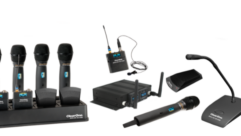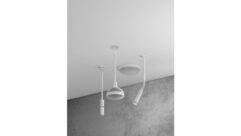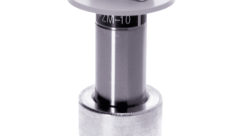
Technology Showcase: Boundary Microphones
Apr 9, 2009 12:00 PM,
By Bennett Liles
From conference rooms to stage performances, the applications for boundary microphones are numerous.

Peavey PSM 3
In the late ’70s, experiments in sound recording showed that within a few millimeters of a hard, flat surface, sound waves coming from different locations are in-phase due to the near stop of air molecules in the area near the surface. These cause a slowdown in the molecules above them, and the effect decreases with distance from the surface. This thin area of slowed waves is referred to as the boundary layer or pressure zone, thus the name boundary microphones or pressure-zone microphones (PZMs). The wave phenomenon results in an increase of acoustic pressure of about 6dB. Because of the wave characteristics in this pressure zone, there is little frequency coloration on sounds from different directions and the level of reverberation and tonal quality varies little as the source of the sound moves around the microphone or, in most cases, the table on which the boundary microphone rests.
The applications for boundary mics are numerous, the most common being the conference tables in boardrooms and meeting suites, but they are also used in piano pickup and for voice in situations where the speaking person cannot be right next to the mic. The boundary effect is also used in picking up stage performances by using cardioid microphones laid on foam pads, called mic mice, along the front of the stage, although placement can result in some frequency coloration. More recently, there have been versions developed for permanent table mounting where the microphone is actually screwed into a hole in the table surface. A wide variety of mics of this type has spread rapidly through the industry. Nearly all are condenser types with very good frequency response. In this survey, we will have a look at some examples of each type.
With a cool appearance vaguely reminiscent of a stealth fighter, the C 680 BL from AKG has a cardioid pickup pattern with a frequency response of 60Hz to 20kHz and an A-weighted noise ratio greater than 67dB. The unit operates on 9VDC to 52VDC phantom power and can accept a sound pressure level up to 115dB with 1 percent total harmonic distortion. The C 680 BL comes with a 10ft. cable and a 3-pin XLR connector. The unit’s electrical impedance is less than 200Ω, and it includes a power adapter. The non-reflective black finish is standard, but the unit is suitable for repainting.
The AM-42 boundary microphone from Ansr Audio is an electret condenser type with a cardioid pickup pattern and a three-position low-frequency contour control that extends the versatility of the unit to cover some sound-reinforcement applications. The normal frequency response is flat from 200Hz to 5kHz with a presence bump from 6kHz to 10kHz. Primarily intended for permanent installation, the mic comes with an unterminated cable and a Phoenix connection. The internal impedance is 1,000Ω, and the sensitivity is -65dB with a maximum SPL capacity of 130dB.
Designed for permanent mounting into a conference table or other flat surface, the 220VP condenser boundary microphone from Astatic has the capability of exhibiting a number of continuously variable pickup patterns. The unit is encased in an RF-resistant case and has threads for screwing the body directly into a flat surface up to 3in. thick. The integral 80Hz, 12dB-per-octave high-pass filter removes rumble and room boom, and the design leaves only the smallest structure protruding above the surface. The unit is terminated with a standard three-conductor XLRM connector and includes shock-absorbing polymer bushings.

Audio-Technica ES961RC
The ES961RC cardioid condenser mic from
Audio-Technica features an ultraquiet electronic touch switch, programmable external contact closure for control of external devices, and an LED indicator. There are three modes to which the electronic touch switch can be set:
touch on/touch off, touch-to-talk, and touch-to-mute. A recessed switch on the bottom of the microphone offers either local or remote operation of the switch and a third position on the switch provides external control of the LED. It’s equipped with Audio-Technica’s UniGuard RFI shielding to protect against radio-frequency interference. The condenser mic operates on phantom power from
11VDC to 52VDC.
1
Technology Showcase: Boundary Microphones
Apr 9, 2009 12:00 PM,
By Bennett Liles
From conference rooms to stage performances, the applications for boundary microphones are numerous.

Audix ADX60
For applications requiring a small, movable boundary mic, Audix offers the ADX60 prepolarized boundary condenser microphone with hemi-cardioid pickup pattern. The mic operates on 9VDC to 52VDC phantom power, provides a frequency response from 50Hz to 18kHz, and comes with a 25ft. cable and phantom power adapter (APS-910). The housing is precision die-cast zinc with a 12mm capsule, black e-coat
finish, and steel mesh grille. The audio connection is mini XLR, and the APS-911 battery-operated phantom-power adapter has an on/off switch and bass roll-off. The mic has a signal-to-noise ratio of 65dB and a 250Ω output impedance.
One of the BM series contractor microphones from Avlex, the BM91BJ is intended for tele¬conferencing, distance learning, courtrooms, and meeting chambers. The mic is customizable with interchangeable cartridges of cardioid, supercardioid, and omnidirectional elements available. The design includes a bottom mounted 1/4in. TRS connector for quick placement and removal. The frequency response is 30Hz to 20kHz with a signal-to-noise ratio of 65dB, a maximum SPL capacity of 135dB, and a sensitivity figure of -65dB ±3dB. The case is paintable, and a custom paint mask is included with each microphone.
Bartlett Microphones has just introduced its TM-125 stage floor microphone for theatrical pickup using the boundary-layer principle. The unit can also be used on boardroom conference tables. Using a miniature condenser mic capsule with an asymmetrical placement that reduces standing wave pickup, the TM-125 features a thick steel housing that can withstand being stepped by stage performers. The supercardioid polar pattern directs sound pickup toward performers onstage and away from the audience and orchestra. The frequency response is 60Hz to 18kHz with a signal-to-noise ratio of 94dB at 94dB SPL. The unit produces 3 percent THD at an SPL of 120dB.
The MPC 22 acoustical boundary microphone from beyerdynamic is a permanent flush-mount design for tabletops and ceilings. Condenser mics with a half-cardioid polar pattern typically work well for these applications, and the elastic bearing rings on the mounting shaft help provide mechanical isolation of the mic from vibrations in the mounting surface. The MPC 22 offers a frequency response of 50Hz to 20kHz, a maximum SPL of 124dB at 1kHz, and an A-weighted signal-to-noise ratio of 26dB. The unit operates on 8VDC to 52VDC phantom power, and it connects with a 3-pin XLR at 200Ω output impedance.

Bogen SCU250
For meeting rooms, conferences, and stage productions, Bogen offers the SCU250—a cardioid condenser boundary mic that operates on a phantom power supply of 9VDC to 52VDC. The heavy-duty metal case is isolated to provide insulation from surface vibration, and there are mounting keyways for secure attachment to the mounting surface. The mic provides a frequency response of 20Hz to 18kHz and a sensitivity of -58dB ±3dB, and it comes with a 26ft. quad cable terminated in a male XLR connector. The signal-to-noise ratio is more than 65dB with an output impedance of 250Ω.
Clockaudio markets the C002E omnidirectional condenser microphone for mounting on walls, floors, pianos, and a variety of other flat surfaces in a very low-profile, un¬obtrusive form. Finished in stone gray Nextel, the mic comes with a 24.5ft. cable terminated with an XLR connector. The unit operates on 9VDC to 48VDC phantom power and delivers a frequency response of 30Hz to 20kHz. It has a maximum SPL handling of 120dB with 1 percent total harmonic distortion and provides an A-weighted signal-to-noise ratio of 68dB. The sensitivity is -47dB ±3dB at 1kHz, and there is a switchable bass filter offering -4dB per octave at 400Hz to -6dB per octave at 100Hz.
The C200 series boundary microphones from Communication Technology are a semi-cardioid electret condenser model with phantom powering from 24VDC to 48VDC, and is available with or without on/off switching. The case is isolated from mechanical shock and vibration by a soft neoprene molding. It comes with a 14.7ft. cable terminated in an XLR connector and an output impedance of 600Ω. The mic exhibits a sensitivity of -35dB ±3dB at a frequency of 1kHz and the maximum SPL rating is 130dB. The frequency response is 50Hz to 18kHz, and the C200 is available with or without an on/off switch.
2
Technology Showcase: Boundary Microphones
Apr 9, 2009 12:00 PM,
By Bennett Liles
From conference rooms to stage performances, the applications for boundary microphones are numerous.
One of the tiniest entries in the boundary microphone arena is the MB-1 from Crown International. Once the unit is mounted onto a tabletop, the protruding area is barely bigger than a quarter, and there is a bottom-mounted 1/4in. phone plug for the audio connection. This plugs into a matching female connector provided in an insert mounted beneath the table. When not needed, the mic can be removed and the mounting hole is filled with a disk supplied with the microphone. The MB-1 must be used with the MB-100 interface, which powers up to four of the mics, provides switching connections, and offers balanced outputs from the interface.

DPA Microphones BLM4060
The BLM4060 prepolarized omnidirectional miniature condenser microphone from DPA Microphones has a 5.4mm vertical diaphragm and a rubber disk that holds the microphone element. The unit exhibits a wide frequency response of 20Hz to 14kHz with a 7dB soft boost at 8kHz. Nominal sensitivity is -34dB ±3dB with a signal-to-noise ratio of 71dB at 1kHz and total harmonic distortion is less than 1 percent up to 123dB SPL level. Maximum SPL before clipping is 134dB, and the output impedance is 30Ω to 40Ω. The BLM4060 is powered with a DPA power adapter supplying 5V to 50V.

Electro-Voice RE90B
The Electro-Voice RE90B offers a half-cardioid pickup pattern with a back electret condenser element. The frequency response is 80Hz to 15kHz ±3dB with an output impedance of 200Ω and a maximum SPL level of 130dB with 1 percent total harmonic distortion at 1kHz. The unit operates on 9VDC to 52VDC, and it has a cable that is attached at the microphone end on an internal terminal block with an XLR connector attached at the other end. The RE90B uses about 2.5mA of current, and it has an integrated pop filter for working close to the microphone.

JTS Professional CM-602
Designed not only for conferences but also for stage-production pickup and live music, the CBM1 omnidirectional electret condenser from Gold Line has an exceptionally high 150dB maximum SPL. It is one of the few boundary micro¬phones to incorporate a full-size XLR connector on the mic case, allowing direct connection of standard audio cable. The wide dynamic range of 28dB to 121dB also aids live-music pickup. There is an on/off switch beside the audio connector, along with a second switch for 6dB bass boost and cut to custom-tailor the response. The overall frequency response of the unit is 20Hz to 20kHz, and it operates on 12VDC to 48VDC.

Milab MP-30
The CM-602 unidirectional condenser boundary microphone from JTS Professional is intended for conference, house-of-worship, and theater applications. The CM-602 has a red LED indicator and a large membrane on/off switch right on the front of the mic body. The output connector is a mini XLR male with a standard male XLR at the other end of the supplied cable. The unit has a frequency response of 30Hz to 12kHz, a sensitivity of -53dB ±3dB and a signal-to-noise ratio of 67dB.
The MP-30 pressure-zone microphone from Milab Microphones is designed for sound pickup in applications from pianos to conference rooms, with a frequency response of 40Hz to 20kHz and a maximum SPL handling of 110dB. The microphone has an A-weighted noise level of 24dB with 1mA current draw and an output impedance of less than 200Ω. The unit operates on a 12VDC-to-52VDC power supply and comes with a 6ft. cable.

Nady CBM 40X
The CBM 40X cardioid boundary microphone from Nady has an electret-
condenser element powered from an external 9V-to-52V power supply and is packed in a heavy duty die-cast case with a rubber pad on the bottom for minimizing mechanical rumble and vibration. To maintain the small cross-section, the audio connector is a mini XLR. The supplied cable has the mini XLR on one end and a standard XLR connector at the other. The total frequency response is 50Hz to 18kHz with a maximum SPL capacity of 130dB and an impedance of 250Ω. The CBM 40X is intended for sound reinforcement, professional recording, and conferences.
3
Technology Showcase: Boundary Microphones
Apr 9, 2009 12:00 PM,
By Bennett Liles
From conference rooms to stage performances, the applications for boundary microphones are numerous.

Peavey PSM 3
With a half-cardioid pickup pattern, the Peavey PSM 3 back-electret condenser boundary mic can be used in sound reinforcement, teleconferencing, and recording with a frequency response of 50Hz to 20kHz when used on an infinite boundary. The output level is -35dB at 500V, and the supplied 10ft. cable has a TA3F at the mic end and a standard XLR on the other. The maximum SPL handling figure is 130dB and the dynamic range is 106dB. The unit is powered by a 9V-to-52V power supply and draws only 5mA. The microphone has a sensitivity of -35dBV/Pa and a rated impedance of 50Ω.
Related Links

Technology Showcase: Conference-room Boundary Microphones
While conference-room microphone systems have grown increasingly sophisticated and multifeatured with automatic mixing, chairman-override functions, priority…

Installation Profile: Mission: Invisible
When the Services Group of America (SGA) built its new headquarters in Scottsdale, Ariz., one of the goals was to create an infrastructure that enabled…

University Adds RevoLabs Fusion to Videoconferencing System
The challenge for many schools such as the University of Denver is implementing cutting-edge AV technology into buildings built decades ago. The school recently implemented a high-definition videoconferencing solution by LifeSize…
For classroom use, the Revolabs TableTop wireless boundary microphone can be ordered as the omnidirectional or the unidirectional. Both are the same size and weight and operate in the frequency range of 1.92GHz to 1.93GHz. This provides a transmission range of 65ft. to 100ft., and there is an out-of-range alarm when the RF signal begins to drop out. The lithium-polymer battery provides up to 8 hours of operation time on a full charge, and the mic provides a 100Hz to 6.8kHz audio frequency response with 128-bit encryption for a secure wireless link.
The CM11B omnidirectional condenser boundary microphone from Samson can be mounted on tabletops or walls, and all the electronics are mounted in the mic body rather than requiring an external electronics pack. The unit operates on phantom power at 9VDC to 52VDC, and it incorporates a heavy neoprene rubber pad to decouple the mic body from the wall or table on which it is mounted. The mic body accepts a mini XLR connector and the other end of the 30ft. cable provided with the mic has a standard XLR connector. The unit has a 30Hz-to-18kHz frequency response and a maximum SPL rating of 127dB.

Sanken CUB-01
Available in gray or beige, the CUB-01 miniature boundary microphone from Sanken is less than 1 1/2in. in diameter, and it uses a unique square-shaped cardioid capsule to significantly enlarge the area of the diaphragm and provide a flat frequency response down to 70Hz. The microphone can handle a maximum SPL up to 122dB and operates on 44VDC to 52VDC phantom power. The output impedance at 1kHz is 180Ω and the A-weighted equivalent noise level is less than 16dB. A variety of accessories are provided including a rubber base, windscreen, instruction manual, and vinyl case.
The BLM 03 Cg miniature boundary-layer microphone from Schoeps has an active cable hard-wired to it that allows the mic to be connected to any amplifier in the Colette series except for the battery-operated CMBI model. The
BLM 03 Cg has all the features of the BLM 3g in a smaller size. The frequency range is 20Hz to 20kHz with a sensitivity of 19mV/Pa and an A-weighted equivalent noise level of 12dB. The mic can handle a maximum SPL of 128dB.
Designed especially for speech pickup, the 912 S pre-polarized condenser half-cardioid microphone from Sennheiser has an integrated membrane switch that is programmable for either on/off, push-to-talk, push-to-mute, or always-on modes. The frequency response can be tailored with DIP switches for low cut, low and high boost, low boost, and linear. The frequency response is 20Hz to 20kHz, and the mic uses 48VDC phantom power.
The MX396 Microflex multi-element boundary microphone from Shure comes in two- or three-element configurations: the MX396C/Dual with 0-180-degree pickup and the MX396C/Tri with 90-0-90-degree pickup. The mic has a frequency response of 50Hz to 17kHz and a maximum SPL of 122dB. There are individual outputs for each element, and a programmable mute switch offers several modes of operation. Included in the design are a bicolor status indicator and a logic output for remote LED and mute control.
The MCBM-300 back electret condenser microphone from Speco Technologies is designed for table placement, and it includes a 20ft. cable with a standard XLR male on one end and a mini-XLR at the mic end. With its stealth design, the mic has a unidirectional pattern and provides a 60Hz-to-16kHz frequency response. With a 250Ω impedance, the unit exhibits a sensitivity of -36dB ±3dB, includes a mute feature, and operates on 9VDC to 52VDC phantom power.
4










